Free Online Productivity Tools
i2Speak
i2Symbol
i2OCR
iTex2Img
iWeb2Print
iWeb2Shot
i2Type
iPdf2Split
iPdf2Merge
i2Bopomofo
i2Arabic
i2Style
i2Image
i2PDF
iLatex2Rtf
Sci2ools
BMCBI
2008
2008
Combining classifiers for improved classification of proteins from sequence or structure
Background: Predicting a protein's structural or functional class from its amino acid sequence or structure is a fundamental problem in computational biology. Recently, there has been considerable interest in using discriminative learning algorithms, in particular support vector machines (SVMs), for classification of proteins. However, because sufficiently many positive examples are required to train such classifiers, all SVM-based methods are hampered by limited coverage. Results: In this study, we develop a hybrid machine learning approach for classifying proteins, and we apply the method to the problem of assigning proteins to structural categories based on their sequences or their 3D structures. The method combines a full-coverage but lower accuracy nearest neighbor method with higher accuracy but reduced coverage multiclass SVMs to produce a full coverage classifier with overall improved accuracy. The hybrid approach is based on the simple idea of "punting" from on...
| Added | 08 Dec 2010 |
| Updated | 08 Dec 2010 |
| Type | Journal |
| Year | 2008 |
| Where | BMCBI |
| Authors | Iain Melvin, Jason Weston, Christina S. Leslie, William Stafford Noble |
Comments (0)

